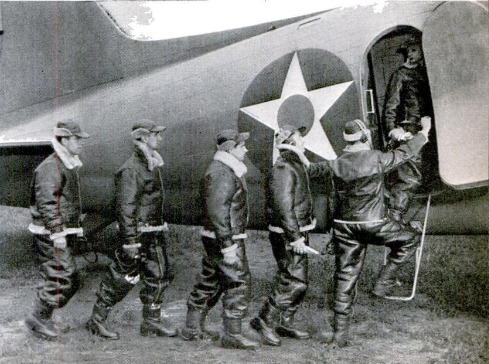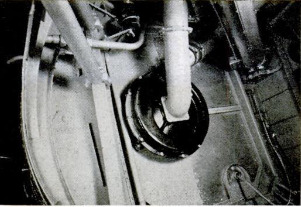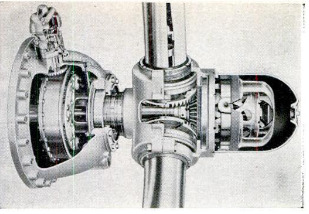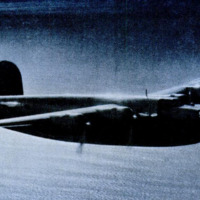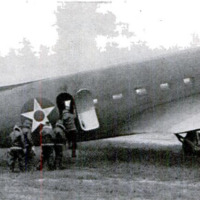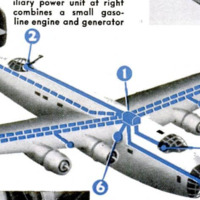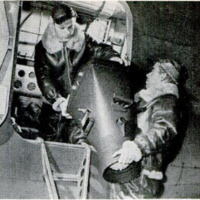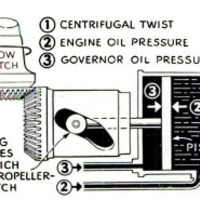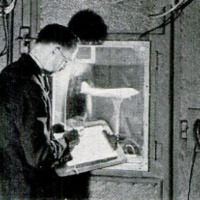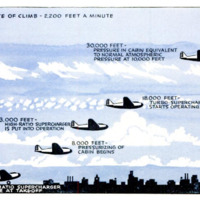-
Title (Dublin Core)
-
War moves to the stratosphere: how science protects high flying air soldiers
-
Article Title and/or Image Caption (Dublin Core)
-
Title: War moves to the stratosphere: how science protects high flying air soldiers
-
extracted text (Extract Text)
-
Wael Bee LEV: CN
HERE is a weird region of frigid, blue-
violet sky from four to seven miles
above the earth's surface where death
awaits any who venture unprepared. Sci-
ence, prodded on by Mars, seeks to prepare
man for flight into this substratosphere so
that he may, singularly enough, deliver
death more efficiently from his bombers
while flying above the reach of hostile in-
terceptor planes and antiaircraft fire. At
the same time science, in other hands, seeks
to extend the ceilings of antiaircraft guns
and interceptors for the purpose of defense
against these high-flying bombing planes.
Safety aside, the bomber crews have
another reason for wanting to seek the up-
per reaches, particularly on long-distance
missions. At these levels—say, a mean alti-
tude of 30,000 feet—the air is only one third
as dense as at sea level. The bomber, flying
at its optimum cruising speed, meets with
approximately one third the air resistance
it would have to overcome at the same
speed at sea level, provided the plane's
“thrust” —forward pull of the propeller—is
kept constant. Thus, greater economy and
higher speed are possible.
But these are high altitudes for heavily
laden bombers and the combat crews—pilot,
bombardier, navigator, radioman, and gun-
ners—that man them. Getting the bomber
and its load up there is the first considera-
tion, and this has been made possible
through engineering innovations such as
highly supercharged motors, constant-speed
propellers, and high-lift wings. Pressurized
cabins, decompression chambers, and oxy-
gen masks—by-products of exhaustive
physiological research and aviation pioneer-
ing—enable the combat crews to withstand
the rarefied atmosphere, decreased pressure,
sub-zero temperatures, and other unaccus-
tomed conditions.
Power gets them up there. The force to
be overcome by the plane's power plant—
this includes the propeller as well as the
motor—is represented by the total amount
of the bomber's “drag,” or resistance to the
air. This is the reason why increased horse-
power, together with efficient streamlining,
spells increased performance. Clever super-
charging is responsible for most of the
power increase that is to be found in to-
day's motors.
This is the means whereby air—which
must be mixed with the proper proportion
of fuel in the engine's carburetor—is sup-
plied to the engine cylinders at pressure
equal to, or higher than that of the sur-
rounding atmosphere. Deprived of this
forced draft, the 1,200-horsepower Twin
Wasp motors which, for example, power the
Air Corps’ big Consolidated B-24 bomber,
would develop only 525 h.p. each at 20,000
feet and about 260 hp. at 25000 feet.
From here up, sans supercharging, the de-
crease would become more rapid; engines,
like humans, must breathe.
The centrifugal-type super consists of an
impeller, or blower, about 11 inches in
diameter driven at high speeds by a train
of gears to which it is attached at the rear
section of the engine in a casing. Two gear
ratios are provided and are referred to as
“low” and “high.” In the Twin Wasp motor,
the blower turns at a little better than
seven times crankshaft speed in low gear,
which is maintained until a certain alti-
tude is reached. Then it is stepped up to
high gear ratio for the long climb to
higher levels. This is done because the
higher ratio would provide too much super-
charging at low altitudes where it was not
required, and the bomber pilot Would have
to fly throttled back to prevent too much of
the fuel-air mixture being fed to the cylin-
ders.
The super not only boosts air pressure to
make up for the diminution of density at
high levels, but also increases motor effi-
ciency by facilitating combustion within the
cylinders. The whirling impeller blades agi-
tate or whip the gas-air mixture into such
turbulence that a higher degree of vaporiza-
tion is attained and the charge is heated.
The ignition flame, therefore, spreads faster
and combustion is more complete. In addi-
tion, the mixture is whirled against “dif-
fuser” fins set in the casing in such a man-
ner that the charge is evenly distributed to
the manifold and cylinders.
The turbo-supercharger, of which we
have been hearing so much of late, is used
to supplement the built-in type and is usu-
ally installed on the outer side or top of the
engine. The motor’s exhaust is discharged
at a pressure considerably in excess of that
of the atmosphere and the turbo-super
utilizes this otherwise wasted power. The
exhaust gases are collected in the manifold
and directed through a small turbine com-
pressor, which, in turn, rotates a centrifugal
blower on the same shaft, sending the boost
on to the carburetor. The used gases are,
of course, discharged after they pass
through the turbine.
Retaining engine power in the substrato-
sphere is only a part of the story. Con-
trollable propellers are required to provide
thrust; after all, the engine's purpose is
solely the turning of the prop. With super-
charged engines, the prop should take big-
ger bites of air at high altitudes than at sea
level, but this can only be accomplished if
the propeller biades can be turned in their
hub to permit change of pitch. Here, too,
is a case of high and low gear. The props
must be in low pitch to permit the bomber
to get off the ground with its heavy war
load and climb. With the blades thus set,
there is less resistance and this allows the
engine to rev up to full power for maximum
pull. In the substratosphere, however, the
blades must be set in high pitch so that they
may take a bigger bite on the rarefied air.
In this position, they offer greater resist-
ance and act us a brake on the engine,
preventing it from racing and thus losing.
efficiency.
The hub mechanisms In the electric hy-
dromatic props permit all this to be accom-
plished automatically through the use of
governors. The bomber pilot has merely to
adjust the propeller controllers according
to the number of rpms at which his en-
gines develop their most efficient speeds.
As the plane takes off and climbs, the blades
‘automatically move from low pitch into
high and the r.p.m.'s remain the same. Thus
the name, constant-speed propeller.
There remained another problem. When
the bomber climbs into the rarer alr, the
‘mixture of gas and air must be leaned out
to keep from having too high a proportion
of fuel to air. Proper manual adjustment
of mixture is so difficult as to be next to
impossible for the busy pilot. A gadget
called an exhaust-gas analyzer was de-
signed on the assumption that a correct
fuel-air mixture, after combustion, pro-
duces a certain percentage of carbon diox-
ide. This can be measured by a certain
type of sensitive metal wire coiled in the
exhaust manifold whose electrical resistance
is affected by the CO, content. The mixture
indicators keep the pilot informed of the
slightest changes. Mixture control is essen-
tial for engine efficiency at high altitudes
and also for the most economical fuel con-
‘sumption.
Then there is the problem of wing design.
It requires quite a bit of lifting surface to
raise a big bomb load into the substrato-
sphere, powerful motors or no. Until re-
cently, high-lift wings were so large that
they offered an incredible amount of “pro-
fle drag”: heavy bombers were slow bomb-
ers for that reason. Along came Harold
Davis with his revolutionary “mystery air-
foil,” a design which had great lifting quali-
ties and little drag. Bomber wing eficiency
is evaluated according to lift-drag ratio.
For example, the average well-designed
wing has a ratio of about 13 parts lift to
one part drag. The Davis airfoil astounded
engineers with its 20-to-1 lift-drag ratio.
Furthermore, it proved, in tests, to have 25
percent less profile drag than the average
wing at low speeds and 10 percent less at
high speeds.
But how about the combat crews, once
these bombers reach the substratosphere ?
Because of the low oxygen content of this
rarefied air, the life-giving element must be
furnished artificially. The initial supply of
compressed gaseous oxygen is carried in a
flask at a pressure of about 120 atmospheres
(1,800 pounds to the square inch). This
tremendous pressure would prove extreme-
ly dangerous if suddenly released. Before
the oxy reaches the airman it passes
from the storage flask to a regulator valve
or flow meter. The user adjusts the flow
to suit his needs, and the oxy then passes
through low-pressure rubber tubing to the
face mask from which he breathes.
If, for any reason, his oxygen supply
should be interrupted at these altitudes, the
result would be much the same as if his
regular breathing were interrupted on the
ground. Within two minutes, the victim
would be rendered unconscious: within an-
other five minutes, he would be dead. Most
men as physically sound as are military
pilots and flight-crew members can func-
tion reasonably well up to altitudes of 15,000
feet. “Anoxemia”—oxygen want—symp-
toms include a deluding sense of buoyancy
and well-being, a dulling of judgment and
thought process, a delaying of reaction
time, a muscular weakness, and difficulty
in breathing. Tests have shown that these
symptoms appear after the flyer has been
at 15,000 feet, sans oxygen, for about half
an hour.
Dr. W. Randolph Lovelace, Mayo Clinic
researcher in altitude flying and physiology,
reports interesting results of tests con-
ducted on rats and guinea pigs in decom-
pression chambers in which high-altitude
conditions are simulated. His findings re-
veal distortion of the animals’ brain cells
from habitual exposure to rarefied air. This,
he said, might conceivably account for the
“queer” behavior of pilots who habitually
fly to high altitudes without oxy equip-
ment. Oxygen want, intense cold, and pres-
sure (or, rather, lack of external pressure)
can be the cause of strange and dreadful
ailments other than brain-cell distortion,
however.
In 1920, Maj. R. W. (Shorty) Schroeder,
in one of history's most spectacular flights,
achieved a world's altitude mark of 33,113
feet, At this point, his oxy supply gave out.
The thermometer indicated 67 below zero.
The plane wis an open-cockpit type and un-
heated. The Major lifted his goggles to
check the oxygen, lost consciousness, and,
with eyes swollen shut, plummeted to with:
in a couple of thousand feet of the ground
before being revived by the normal air
density of the lower altitude. Almost blind,
he miraculously landed right side up. X-rays
of his heart revealed that it had expanded
to three times normal size! His eyeballs
were frozen and he spent some time in the
hospital.
Nitrogen, that inert enemy of high-flying
men and machines, contributes largely to
another aerial malady known as “aeroem-
bolism,” the airman’s version of the “bends”
divers experience after rising to the sur-
face of the water too quickly. Pursuit
pilots, because of the rapid rate of climb
of their ships, are more apt to be afflicted
than the slower-climbing bomber crews,
but the latter are also susceptible. When
the late Big Bill Wheatley, Consolidated
test pilot, took the B-24 aloft on the first
high-altitude flight, a strange thing hap-
pened. He not only experienced the pain of
aerial “bends” but, when he landed, the
vision of his right eye was nearly gone. His
sight remained this way for several days,
then he flew to the Mayo Clinic in despera-
tion. Treatment and long ses-
sions in the clinic pressure
chamber restored Wheatley's
sight.
What occurs is that one’s
blood, tissue fluids, and joints
give off, at high altitudes, their
nitrogen in the form of bub-
bles. The breathing of oxygen
replaces the “evaporated” ni-
trogen to some extent, but the
ideal aeroembolism insurance
is for the pilot to decompress
himself before he goes aloft.
The first experiment of this
sort, under actual flight con-
ditions, was performed on Milo
Burcham, Lockheed test pilot, during the
altitude tests on the speedy, twin-engined
P-38. He first entered the decompression
room, donned the BLB oxygen mask, and
pedaled a gymnasium-type bicycle slowly
for half an hour while breathing oxy. This
strange procedure works off the nitrogen
bubbles. He put on his flying suit, switched
the oxygen supply to an emergency flask
in the right leg of the suit, walked to the
plane, and, immediately after entering the
cockpit, connected hin inhalation apparatus
to the P-38's oxy tanks. Then he took off
and climbed into the stratosphere, suffering
no aeroembolism. From the time ho entered
the decompression room until he landed,
Burcham breathed only oxygen. One breath
of fresh air containing nitrogen would have
undone all his “supercharging” efforts.
Proper diet Is another defense against the
strange perils of the substratosphere. A
light diet high in carbohydrates ia recom.
mended by flight surgeons; pure chocolate
is ideal. More oxygen is required to oxidize
a fat than a carbohydrate because the fat
must have extra oxy to unite not only with
the carbon In the food to form carbon
dioxide, but also with the hydrogen to form
water. All diets must include non-gaseous
foods, because at our optimum altitude of
30,000 feet, any gas in the stomach and in-
testines will expand to four times sea-
level volume,
There is still another danger facing the
high-venturing fiyers. In normal life on the
earths surface, we are accustomed to
pressure of 14.7 pounds to the square inch
on every part of the body. When we climb
into the substratosphere, and even into the
stratosphere proper—around 37,000 feet—
pressure becomes practically nil. Deep-sea.
fish, when brought to the surface, expand
and thelr eyes bulge because they are
formed to withstand the pressures of the
deep. Flyers do not behave so queerly, but
their organs dilate and severe pain’ and
damage result from the lack of accustomed
pressure. The late Wiley Post
used a pressure suit in his
pioneering flights to overcome
this condition, but the trend
of development drifted toward
the use of sealed pressurized
cabins.
Capt. D. W. “Tommy” Tom-
linson, T.W.A.’s vice president
in charge of engineering, who
has probably spent more time
above 30,000 feet than any
other pilot, has this to say:
“The adaptation of pressur-
ized cabins to bombers is not
too difficult. Only the portion
of the fuselage containing the
flight crew and adjacent rest space need be
pressurized. This calls for pressurizing the
nose of the airplane, which is relatively safe
from the effects of machine-gun fire.
“An air lock must also be incorporated
s0 that, in emergency, gun crews may move
out of the pressurized section to man their
guns in the after portion of the fuselage.
Oxygen must be available at the gunners’ battle stations.”
The airplane's fuselage should be circular
rather than of oval or elliptical cross sec-
tion, because a tube under internal pressure
always forms a circle, pressure being
equal at all points. The hump formed by
the pilot's cockpit is reduced, or completely
eliminated. Fortunately, the designers
found that dural heavy enough for the skin
of a big bomber was also sufficiently strong,
when properly stressed, to withstand the
internal pressure at high altitudes. Win-
dows are of Plexiglas, chosen in preference
to glass because of its high strength-weight
ratio.
This pressure is obtained through super-
charging. Air is drawn from a duct in the
leading edge of the bomber’s wing. From
here it passes through a water separator,
through two large superchargers driven by
the ship's inboard motors, through a steam
radiator in the wing, through the inter-
cooler to reduce the temperature of the
air, through the inflow regulator, on through
the cabin, out through the floor, then
through the outflow valve which is a part
of the same unit with the inflow regulator.
A flight engineer controls the supercharg-
ing from a special panel behind the pilot's
station.
Getting the interceptor and its pilot up to
meet these substratosphere bombers in-
volves even more ironing. Like the bomber,
the interceptor must be fitted with high-
powered engines whose power is kept high
by the use of both centrifugal and turbo-
superchargers, constant-speed propellers,
automatic mixture controls, etc. There
are, so far as is known, no pressurized pur-
suit planes or interceptors. The reasons:
The cockpits are, of necessity, irregular in
shape and they are small. Even if they
could be shaped so as to take pressurizing,
the ship's supercharging equipment would
weigh so much that some of its perform-
ance would be sacrificed. The only imme-
diate solution seems to be the use of pres-
surized suits of the Wiley Post variety.
Present suits are electrified to provide
warmth for pursuit pilots and bomber
crews, and the novel feature of these is the
“electric underwear.” This is a heavy woolen
union suit into which wires are sewn in
parallel waves—to give an accordion effect
to permit stretching and body movement—
for heating. This unit is covered by an
outer shell of heavy gabardine, and heated
boots and gloves complete the outfit. The
heater control insures comfort through a
range of temperatures from 70 above to 60
below zero. These suits are many pounds
lighter than the heavy leather and sheep-
skin-lined garments formerly used by the
Army and Navy aviators. Cockpit heaters
are also used to keep the fighter pilot's
office warm. Plane performance and bodily
comfort are only a part of the fiyer'’s wor-
ries, however, There are operational prob-
lems at these high altitudes which call for
a very special kind of flying technique. He
must watch himself at every turn, both
literally and figuratively.
A steep turn at 30,000 feet, if not proper-
ly executed, may cost the interceptor pilot
his life. It's all a matter of G load factors
and wing loading. The air is one third the
density of that near the ground, and the
plane’s power plant—engine and propeller
—is at its maximum power output to keep
the “thrust” normal. The sea-level stalling-
landing speed of his ship is, say, 75 miles
per hour, with the wing flaps down. With
flaps up, it is 95 mph. POPULAR SCIENCE
readers know about the manner in which
G's build up in a pull-out from a dive. A
Bell Airacobra interceptor weighs 6,662
pounds and is subjected to the force of 1 G
in level flight in smooth air. Deviation from
this straight, level course results in a
higher load factor acting upon the wings—
the number of G's depending upon the speed
and sharpness of the maneuver. Speaking
aerodynamically, a vertical or near-verti-
cal turn is a lateral pull-out, and in the
upper half of a loop the plane describes an
upward pull-out. A 3-G acceleration in any
direction imposes a 19,986-pound load on
the Airacobra’s wings. Therefore, the stall-
ing speed is increased about 55 percent.
We are talking in terms of low-altitude
performance. Up in the substratosphere,
the stalling speed is proportionately higher
because of the rarefied air. A steep, high-
speed turn causes the ship to “mush,” or
skid and this sliding often slows speed to
the stalling point, which at these altitudes
can be as much as 70 percent higher than
normal because of the imposed G-load fac-
tor and the high wing loading inherent in
any high-performance interceptor.
Not only will the ship stall and spin out
of a too-tight turn, but it will fall out of
control several thousand feet before the air
becomes dense enough for the controls to
gain a grip and right the plane! During this
time, of course, the interceptor pilot is cold
meat for the enemy fighter who follows
him down.
Altitude fighting is mostly a hit-and-run
affair because of the impossibility of close-
in fighting and rapid maneuvering. The
pilot lines up the bomber or enemy fighter
in his reflector sight, fires away, then pulls
away—gently. There is not only the danger
of stalling, but also the danger of “blacking
out.” Medicos believe that this occurs more
readily at high altitudes.
If, for any of a number of reasons, the
interceptor pilot or members of the bomber
crew are forced to bail out of their high-
flying craft, they must carry oxygen with
them or perish. This is not difficult. The
rubber supply tube is disconnected from the
plane’s tank and attached to a small flask
in the flying suit. Sans oxygen, one would
have to drop from 35,000 feet to 20,000 feet
in just one and one half minutes if one were
to remain conscious. He could fall free
within this time, but anoxemia suffered
during even this short interval might affect
him so as to make thinking cloudy. He
could, conceivably, forget to pull the ‘chute
ripcord. On the other hand, if he bailed out
at 35,000 feet and opened his chute imme-
diately, about ten minutes would be required
to float down to 20,000 feet. He would
never reach earth alive.
‘The solution to these problems and others
is being sought by the Air Corps’ aviation-
medicine staff at the Wright Field Phys-
iological Research Laboratory, working in
conjunction with the Mayo Clinic. Among
the noted researchers are Capt. Otis D.
Benson, Dr. W. Randolph Lovelace, Dr.
Walter M. Boothby—coinventors of the
BLE “oronasal” oxy mask which won them
last year's Collier Trophy—Capt. Harry G.
Armstrong, Dr. John W. Heim, and Dr.
Arnold D. Tuttle. The stratosphere keeps
its secrets well, but there is much that, of
necessity, must be learned if our bombers
are to fiy much higher and our interceptors
are to be able to keep their present tactical
advantages over hostile bombers.
-
Contributor (Dublin Core)
-
James L. H. Peck
-
Language (Dublin Core)
-
Eng
-
Date Issued (Dublin Core)
-
1941-11
-
pages (Bibliographic Ontology)
-
102-109, 220, 222,224
-
Rights (Dublin Core)
-
Public domain
-
Archived by (Dublin Core)
-
Sami Akbiyik
 Popular Science Monthly, v. 139, n. 5, 1941
Popular Science Monthly, v. 139, n. 5, 1941



